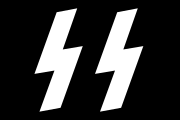Karl Jäger
| Karl Jäger | |
|---|---|
.jpg) Karl Jäger | |
| Born |
20 September 1888 Schaffhausen, Switzerland |
| Died |
22 June 1959 (aged 70) Hohenasperg, Germany |
| Allegiance |
|
| Service/branch |
|
| Years of service |
1914–1918 1933–1945 |
| Rank | Standartenführer (Colonel) |
| Unit | Einsatzkommando 3 |
![]() Karl Jäger (20 September 1888 – 22 June 1959) was a Swiss-born mid-ranking official in the SS of Nazi Germany and Einsatzkommando leader who perpetrated acts of genocide during the Holocaust.[1]
Karl Jäger (20 September 1888 – 22 June 1959) was a Swiss-born mid-ranking official in the SS of Nazi Germany and Einsatzkommando leader who perpetrated acts of genocide during the Holocaust.[1]
Early life and career
Jäger was born in Schaffhausen, Switzerland. In World War I he received the Iron Cross (1st Class) and other awards. After World War I, Jäger, an orchestrion maker by profession, obtained a managerial position with the Weber orchestrion factory in Waldkirch. He joined the Nazi Party in 1923 (serial no. 359269) and founded the local party chapter, as a result of which he became known as "Waldkirch's Hitler". The Weber company went bankrupt in 1931,[1] and he was thrown into unemployment for several years, but – according to his own claims – he spurned unemployment support from the government of the Weimar Republic, which he despised. By 1934, he had used up all his savings, and his wife Emma separated from him, though their divorce was not formalized until 1940.[1] He joined the SS as early as 1932 (serial no. 62823), but his rise within the SS under Heinrich Himmler began only in 1935.[1]
He was assigned to Ludwigsburg, then to Ravensburg in 1935, and to Münster in 1938, where he was named head of the local office of the Sicherheitsdienst (SD). During the invasion of the Netherlands on 10 May 1940, Jäger was named commander of Einsatzkommando 3, a unit of Einsatzgruppe A.
Mass murders in eastern Europe
Jäger was instrumental in the brutal and systematic destruction of the Jewish community of Lithuania. From July 1941 until September 1943 Jäger served as commander of the SD Einsatzkommando 3a, a sub-unit of Einsatzgruppe A under Franz Walter Stahlecker, in Kaunas. Under Jäger's command, the Einsatzkommando, with the help of Lithuanians, shot Jewish men, women and children indiscriminately. It perpetrated the Ninth Fort massacres of November 1941.[2]
During this time, reports detailing calculated acts of mass murder were routinely submitted to his superiors. Some of these reports survived the war and are collectively referred to as the "Jäger Report". Reassigned back to Germany near the end of 1943, Jäger was appointed commander of the SD in Reichenberg in the Sudetenland.
.jpg)
The Jäger Report
The actions by Einsatzkommando 3, including the Rollkommando Hamann killing squad were tallied by Jäger himself. The report keeps an almost daily running total of the liquidations of 137,346 people. Among all Nazi documents detailing calculated acts of mass murder and other atrocities, the "Jäger Report" is one of the most horrifying. It provides a detailed account of the murderous rampage of this "special squad" in Nazi-occupied Lithuania.
Escape, capture, and suicide
Jäger escaped capture by the Allies when the war ended, assumed a false identity, and was able to assimilate back into society as a farm hand until his report was discovered in March 1959. Arrested and charged with his crimes, Jäger committed suicide by hanging himself in prison in Hohenasperg while he was awaiting trial in June 1959.
Notes and references
- 1 2 3 4 Vincas Bartuseviécius; Joachim Tauber; Wolfram Wette (2003). "Jägers Karriere in der SS 1936–1941". Holocaust in Litauen: Krieg, Judenmorde und Kollaboration im Jahre 1941. Böhlau Verlag Köln Weimar. pp. 80–82. ISBN 3412139025. Retrieved 22 July 2013.
- ↑ Friedlander, Henry (1995). The Origins of Nazi Genocide: From Euthanasia To The Final Solution. Chapel Hill, NC: University of North Carolina Press. p. 289.
- Klee, Ernst, Dressen, Willi, and Riess, Volker, "The Good Old Days" – The Holocaust as Seen by its Perpetrators and Bystanders, (translation by Deborah Burnstone) MacMillan, New York, 1991 ISBN 0-02-917425-2, originally published as (German) Klee, Ernst, Dreßen, Willi, and Rieß, Volker (Hrsg.): Schöne Zeiten. Judenmord aus der Sicht der Täter und Gaffer. S. Fischer, Frankfurt / Main 1988. ISBN 978-3-10-039304-3
- (German) Krausnick, Helmut, and Wilhelm, Hans-Heinrich: Die Truppe des Weltanschauungskrieges. Die Einsatzgruppen der Sicherheitspolizei und des SD 1938–1942. Deutsche Verlags-Anstalt, Stuttgart 1981, ISBN 3-421-01987-8
- (German) Seljak, Anton: Monolithisches Leitbild und soziale Heterogenität einer Elite. Untersuchungen zum Ordensgedanken der SS und zur sozialen Stratifikation des SS-Führerkorps. Including a socio-biographical excursus on Karl Jäger. Universität Basel, 1992 (vgl. "Alexandria": Online-Katalog (OPAC) des Bibliotheksverbunds der Schweizerischen Bundesverwaltung)
- (German) Stang, Knut: Kollaboration und Massenmord. Die litauische Hilfspolizei, das Rollkommando Hamann und die Ermordung der litauischen Juden. Peter Lang, Frankfurt am Main [u.a.] 1996, ISBN 3-631-30895-7

